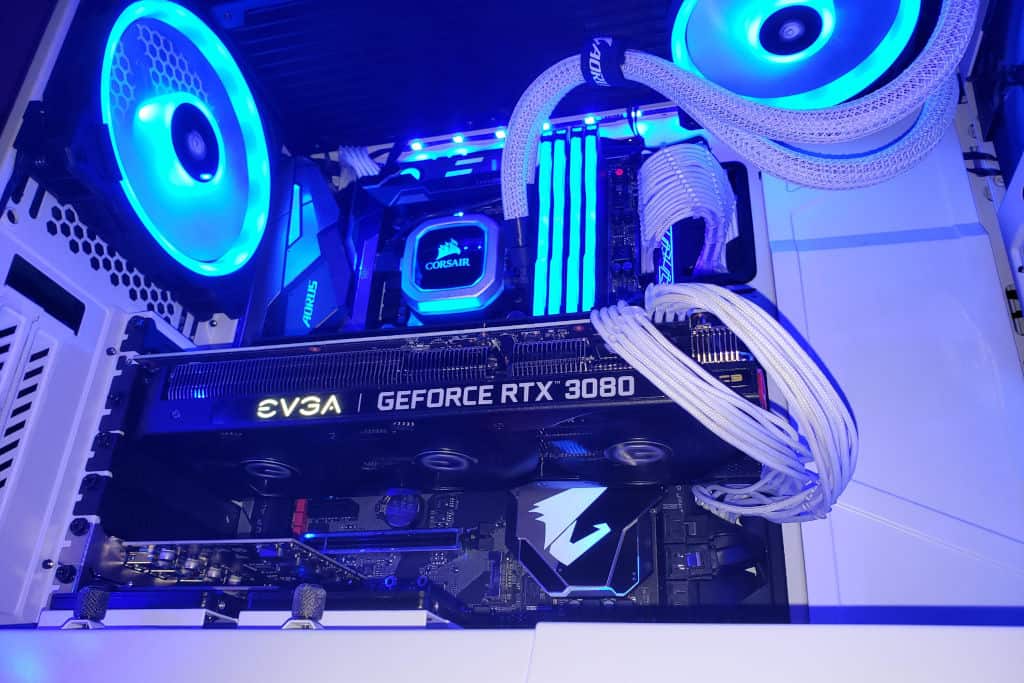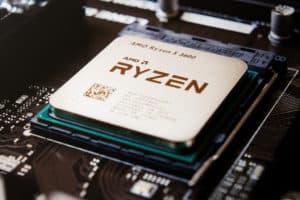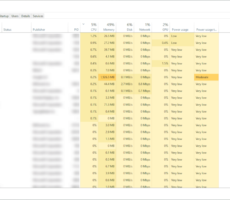Note: Some links may earn us a commission at no cost to you. Learn more in our privacy policy.
A Graphics card (GPU) is one of the main components of the computer and the most important when it comes to mining, gaming, or production work. We saw that CPUs can last for a long time, but what about the average GPU lifespan?
If you run your graphics card at stock voltage, don’t overclock it and properly cool it, even a daily used GPU can last 6 years and beyond. If you push your GPU by overvolting and overclocking while keeping it cool, it should typically last the warranty period of 3 years.
Generally, if a graphics card dies within 3 years of buying, it usually wasn’t due to the high usage but a poor electrical or thermal design, or poor maintenance. A properly cooled GPU doesn’t usually fail after only a few years, regardless of how much it’s been used.
Electronics degrade very slowly just from having electricity passed through them, so graphics card lifespan is mostly affected by the temperature of the card.
How Long Does a GPU Last?

A properly cooled graphics card in a clean environment can generally last far beyond its warranty period of 3 years. On the other hand, flashing your BIOS and pushing your card beyond what it is rated for, may not last through its warranty.
If properly cooled, GPUs very rarely fail from simply being used.
If you asked an expert how often they see a failure in consumer electronics due to electromigration, they’ll probably tell you that it’s rare. The main reason GPUs fail is usually due to repeated thermal expansion and contraction, and sometimes due to physical damage.
Therefore, keeping your video card cool is the #1 priority for extending its lifespan.
Additionally, regularly dusting off your card can prevent particle buildup which could act as an insulator, raising the internal temperature.
Both AMD and Nvidia graphics cards can last for years running 24/7 while being heavily used, but also properly cooled. So even though the amazing RTX 3080 can run up to 90°C, that doesn’t mean that it should.
If properly cooled, GPUs very rarely fail from simply being used.
The 2nd thing you need to keep in mind is that thermal paste applied to your GPU at the factory is probably useless after about 5 years, so you should look into reapplying it when you see the temps getting really high.
Do Graphics Cards Go Bad Over Time?
Graphics cards don’t slow down over time, and as long as they are kept cool, there should be no major degradation or damage over time. They do wear out over time mostly due to heat, because of the contraction and expansion of the card components.
Video cards can last for a long time, and they also don’t go bad if unused, and any kind of damage other than heat and voltage will take too long to become noticeable.
However, for those storing GPUs long-term, it’s advisable to keep them in anti-static bags to protect against potential electrostatic damage.
How Long Do GPUs Last When Mining?
Miners run their cards 24/7 literally for years, and they still work afterward. With proper maintenance and cooling, cards should outlast 3 to 5 years while mining. The chip on the card is rarely at 100% usage, though some cryptos are memory intensive.
One of the things miners do to prolong the lifespan of their cards is undervolting the GPU, while at the same time finding a good ratio of performance vs power balance to increase the profits long-term. They’re usually kept at peak performance at the lowest possible temperatures.
Furthermore, positioning the mining rig in a room with optimal humidity levels can deter corrosion on GPU connectors, preserving the card’s health.
When it comes to prolonging the lifespan of your GPU while mining, it comes down to regular maintenance, cleaning, and applying the thermal paste twice a year on the GPU core.
Additionally, changing the thermal pads for the GPU VRAM chips, especially on the 3000 series cards will make your graphics card live longer and give out a great performance for years.
Does Mining Damage the GPU?
Mining itself doesn’t damage the GPU or the CPU for that matter, any more than gaming or software usage damages it. If you keep your GPU cooled in a dustless environment, then you’re fine. Mining software is not malicious either, any more than any other code you run on your computer.
Therefore, mining doesn’t inherently damage your graphics card. It is the conditions where the GPU is located that can damage it. Insufficient cooling is the #1 reason why GPUs fail during mining, so as long as you maintain cool temps and not keep your GPU at 100% for long periods you’re fine.
How Long Do GPUs Last in Gaming?
As long as you keep your GPU cool, in a good environment with good airflow, your graphics card should typically last at least 5 years in heavy gaming, if not longer. Properly cooled GPUs can last indefinitely, and gaming shouldn’t be your major concern.
How Long Does an Overclocked GPU Last?
Pushing your GPU with overclocking while keeping it cool, should typically last at least the warranty period of 3 years. GPUs today are made with overclocking in mind, so as long as you keep the GPU cool and in a dustless environment, it will serve you well for a long time.
Overclocking is often encouraged and it’s nothing new or dangerous, as long as you keep it in a good environment and use software to monitor its temperatures.
Manufacturers often incorporate safeguards to prevent damage due to reasonable overclocking practices, and voltage regulators on modern cards are built to handle the stresses of overclocking.
What’s a Safe GPU Temperature?
Your GPU can get run really hot without any problems, but they should typically run at temperatures somewhere below 75-80°C because for most cards that’s when the GPU starts to thermal throttle, meaning the performance starts to suffer due to high temperatures.
This is just general advice, and many cards can work beyond 80°C for years without problems. If you plan to replace your GPUs regularly, then you can simply run an aggressive fan curve on your card, and this way you only risk your fans dying out early, while your GPU runs cool.
For mining, a safe temperature is up to 60 degrees on the GPU and 90 degrees on VRAM for long-term stability. Even up to 70-75 on the GPU is fine if VRAM temperatures are also in check and below 98.
Graphics card overheating could be dependent on several factors, but usually, it’s either that the card isn’t strong enough for what you’re using it for, your case airflow is bad or your GPU fans are failing.
How to lower GPU temperature?
In general, you can lower your GPU temps by using an aggressive fan cooling curve in MSI Afterburner, Argus Monitor, or Fan Control. You can also get a better case, replace GPU fans, open one side of your case for better airflow or replace a thermal paste on the GPU.
Also, considering custom cooling solutions, like water cooling or larger aftermarket coolers, can deliver significant temperature drops, enhancing performance stability.
In mining, you can lower GPU temps by running the cards in a good case, keeping your case door open, having a really good cooling solution, undervolting your card, and/or applying thermal paste twice a year. You can also do this while gaming.
In gaming, you can lower your GPU temperature by limiting the FPS in the game to something like 60 or 90 so your card can rest a bit. Enabling Vsync usually does this automatically.
Regularly updating your GPU drivers can also improve thermal efficiency, as manufacturers often release optimizations to manage heat output better.
What Are the Symptoms of a Bad Graphics Card?
Common symptoms include:
- Artifacts in apps
- Random crashes
- Sparking, burning, or smoking from the GPU
- no POST (computer won’t start)
- Terrible performance in gaming
Graphics Card Failure Test
Graphics card failure can be tested in many different ways, and one of the easiest ones is to put your card in another computer to eliminate your other components as the cause of the failure.
How to check if GPU is faulty?
Here’s how to tell if your graphics card is dying:
- Put the card in another PC and see if the problems persist.
- Run HWiNFO and check the reading for memory errors
- Replace your PSU (power supply unit) with a stronger one
- Try a different HDMI slot or a different cable
There are a few graphics card diagnostic options for you, such as checking the motherboard sensor for errors, checking your GPU for damage and debris, and doing a GPU benchmark, which tests your card under heavy load.
If the motherboard sensor shows some errors you should consult your motherboard manufacturer’s notes to see what it means.
How Long Do GPU Fans Last?
GPU fans generally last between 35,000 and 50,000 hours, which roughly equals 4 to 6 years of continuous 24/7 use in an optimal dustless environment. In reality, fans usually last about 2 to 3 years, with some dust and heavy usage of the GPU.
GPU fan lifespan is dependent on its build quality, its fan curve, and the amount of dust it operates in. Regarding the fan curve, sometimes it’s better to have it constant, rather than changing constantly. if your GPU constantly heats up and cools down quickly, the fan changes RPM much more frequently which may cause the fan to fail sooner.
What’s the safe speed for a GPU fan?
A good recommendation is not to run your fans above 80% unless during heavy load. A safe speed is the one where your fan is keeping your GPU temperature below 75-80°C (167°F), above which your GPU will generally start to thermal throttle.
Constant fan speed is typically better, especially for mining, compared to regular acceleration and deceleration, because this is known to kill fans early. You can set up a customized fan speed curve with software such as MSI Afterburner, Argus Monitor, or Fan Control depending on your needs and preference.
Here’s a YouTube tutorial on how to set up a Fan Control by Rem0o:
Even without the software, the temperature of your graphics card is automatically controlled when cooling is needed, so you don’t have to worry about it.
Keep in mind that if you plan to upgrade regularly, fans will die out way after your GPU becomes obsolete. If that’s the case, you can safely set an aggressive GPU fan curve in your software of choice, and don’t worry about it.
Is it bad to run GPU fans at 100%?
Running your GPU fan at 100% speed isn’t considered healthy for anything other than quick testing. GPU fans should never run at 100% at idle, while the only downside to running the fans at 100% all the time is that they’ll wear out faster.
If you absolutely need to run your fans at 100% and you’re worried about a GPU fan failure, just have a few aftermarket GPU fans ready.
However, it’s usually better to have an aggressive fan curve than run the fan at 100% constantly. The fans can definitely run at 100% for a long time unless they change their RPM constantly, but the question is should they? If your GPU is running hot with fans at 90%, then you should look at the GPU itself and your cooling system to solve the temperature issue.
How Often Do Graphics Cards Need to Be Replaced?
This will depend on the person and your needs, but typically, people change their graphics cards either when they show signs of failure, or when they’re not getting the performance from their system, and that’s usually every 3 to 5 years.
This timeframe varies depending on what you need the GPU for, and the availability of the GPUs on the market. These days GPUs aren’t readily available at the stores and the prices are high, so you should take care of yours as best you can.
Some people will try to squeeze every drop of performance they have left and won’t upgrade if their GPU is still going for a reasonable price on the market, while others will upgrade the moment their GPU starts struggling in the latest game, software or if the new card simply seems like a better investment. In the end, it comes down to personal preference.
How Long Can a GPU Run at 100%?
As long as you can run your GPU at 100% without thermal throttling and have proper cooling, your GPU can last this way for years. Lots of games and miners use the GPU at 100% for years before they start to show the signs of degradation.
Smart thing is to use monitoring software such as GPU-Z, HWiNFO, or some other software to notify you if the temps get a bit too high.
“May our FPS be high, and our temperatures low.”








